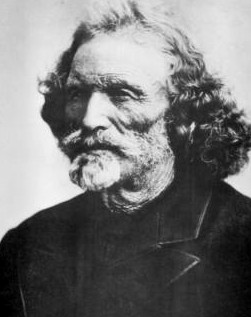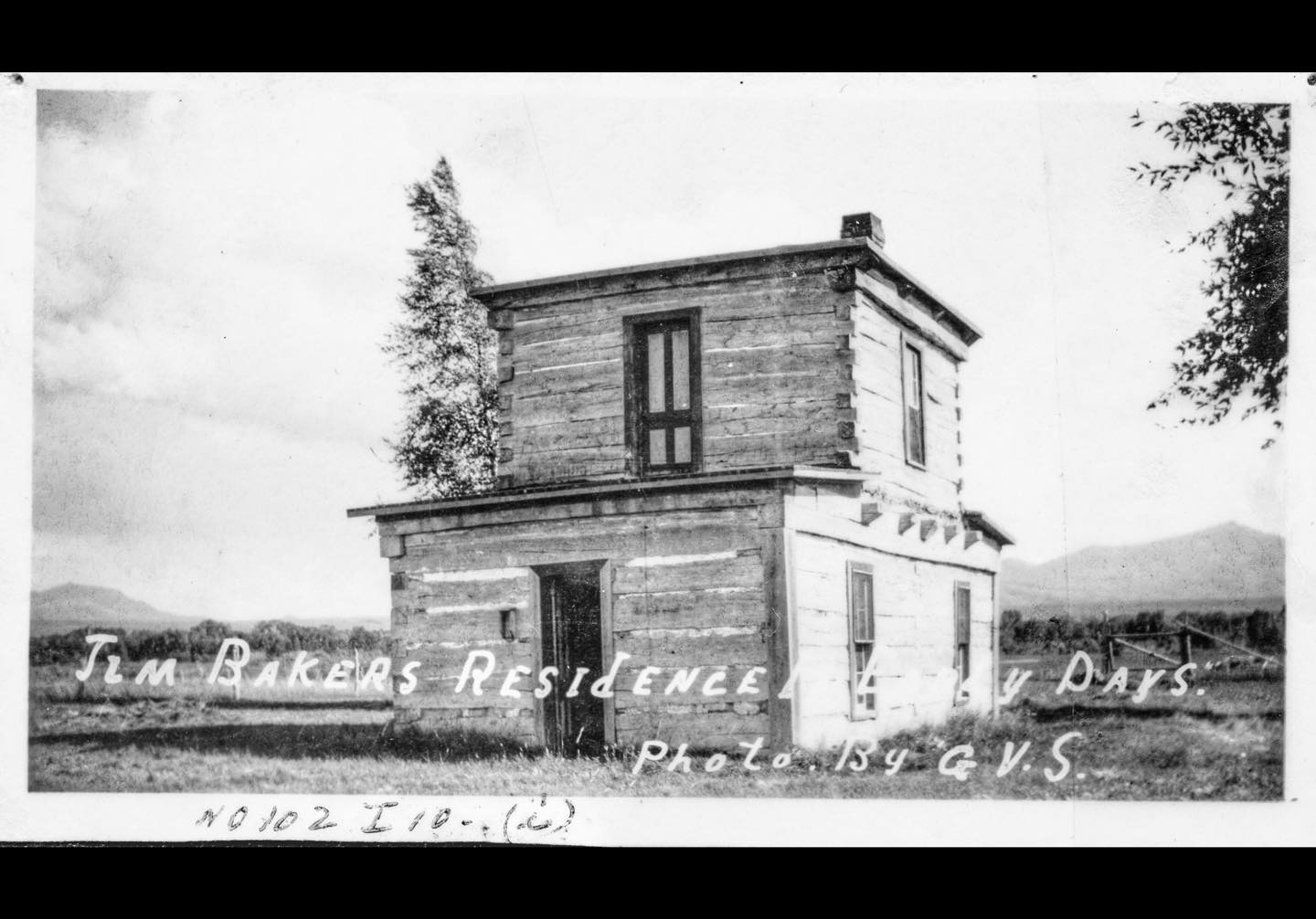Jim Baker Biography
Our Jim Baker Cabin.
The most well know building at the Little
Snake River Museum, the Jim Baker Cabin,
housed one of the last great mountain men of
the American West. Built in 1873, the home
now sits just a few miles from its original
site at the base of Savery Hill. At the age
of 55, Baker built the cabin completely by
hand. When it was constructed, it was one of
the only permanent buildings in a land
filled with Shoshoni teepees. Baker held
close relationships with this tribe and
Native Americans throughout the area, even
marrying two of the Shoshoni chiefís
daughters, Marina and Mary. With these women
and his wife Eliza, Baker fathered 11
children, eight of whom grew into adulthood.
Along with being the family home, the house
served as a trading post. Also, right before
the Meeker Massacre, it acted as a fort for
valley settlers. During its brief time as a
fort, a third story was added to the cabin
to be used as a lookout. In 1898, Baker died
in the cabin at the age of 80. Nearly twenty
years later, in 1917, the State of Wyoming
relocated Bakerís cabin to Frontier Park in
Cheyenne, Wyoming. The cabin remained in
Cheyenne until Paul McAllister, Bakerís
great-grandson, directed its reconstruction
and donation to the Little Snake River
Museum.
Jim Baker, was born in 1818 and
died in 1898 and is buried nearby in the
Baker Cemetery along with many of his family
members and descendants. The Madeline House,
also located at the museum, belonged to his
daughter Madeline Baker Adams.

Jim Baker, of
Scotch-Irish descent, was born in Illinois
in 1818. As a young man, he traveled on foot
to St. Louis, Missouri, where he met Jim
Bridger. Baker signed a contract with the
American Fur Company to join a trapping
expedition, marking the beginning of a new
adventure.
May 25th, 1839, on the old
steamer, St. Peter, traveling up the
Missouri to Kansas City,
the party
was transported on keel boats traveling to
Grand Island on the Platte River, reaching
the Laramie Plains where they had their
first encounter with the Red Man. They
continued down the Medicine Bow and Laramie
Rivers to Sweetwater, crossing South Pass to
arrive at Fort Bonneville.
1838 to
1839, Baker hunted and trapped the Wind
River Mountains. When spring broke in 1840
he returned home to Illinois.
During
the spring of 1841, Jim set out for his
second journey to the Rocky Mountains,
traveling back across the Laramie Plains,
over South Pass, down the Green River to
Bridger's camp at the Henry's Fork. Bridger,
who was worried about his associate Henry
Frapp, sent Baker along with others to
search for the lost party who had been
trapping at the Base of Squaw Mountain on
the banks of the Little Snake River.
On August 21, 1841, Jim Baker noticed a
cloud of dust arising on the southwest side
of Bastion Mountain. A shower of arrows flew
from a cliff overhead; they had encountered
hostile Indians. This was the start of one
of the most memorable fights that ever took
place between the Indians and the white men
in the Rocky Mountains. Captain Frapp died
early in this fight, leaving Jim Baker, age
21, to take charge. This battle gave a new
name to Bastion Mountain--Battle Mountain.
August 27th, 1841, after the Indians
retreated the trappers departed from Battle
Mountain and returned back to Bridger's
camp.
1847, Baker settled for a short
time in Salt Lake City Utah where he became
a government Scout and guide. His talent to
speak the Shoshone language and use Arapahoe
sign as well as his knowledge of the rivers,
trails, mountains and Indian War trails led
him for Old Mexico where he returned with a
regiment of soldiers to Fort Bridger.
General Johnson who was in command of this
army was sent here to protect the emigrants,
as they encountered hardships with the
Mormons on their journey westward. This was
known as the Mountain Meadow Massacre.
1859, Jim Baker took up homestead near
Denver, three miles north on Clear Creek. He
built an adobe brick building at what is now
53rd and Tennyson Street, just west of Regis
College. He built a toll bridge as well as
owned the first coal mine in Colorado where
Eris is now, 18 miles west of Denver.
1859, Baker was appointed Captain along
with General Chivington who lead the fight
at Sand Creek.
1873, Jim left
Colorado and bought a ranch near Savery
Wyoming, he built a cabin from cotton wood
trees that were chopped by Jim and his three
daughters, Isabel, Madeline and Jennie. The
cabin had three stories, the upper was used
as a watch tower but as the threat of
hostility gave away the third story was
removed.
1875, Jim Baker served to
General Custer as a scout during the Fight
at Rosebud in the Black Hills.
1881,
Jim Baker once again was ask to aide in yet
another Battle, The Meeker Massacre led by
General Thornburg.
May 15, 1898, Jim
Baker died in his cabin near Savery,
Wyoming. He was loved and respected by all
and was known as Honest Jim Baker.
1917, The Baker Cabin was removed from
Savery and taken to Frontier Park in
Cheyenne, Wyoming.
July, 1976, the
home of Jim Baker returns home to Savery
Wyoming and is now located at the Little
Snake River Museum. The cabin was
reconstructed under the direction of Jim
Baker's Great-Grandson Paul McAllister who
still lives in Dixon Wyoming.
In a
little cemetery overlooking the Little Snake
River Valley that after scouting from
Missouri, to Oregon, from California to the
Kansas territory, through Salt Lake and over
our own Rocky Mountains lays the body of Jim
Baker, one of the greatest scouts, trappers
and Indian fighters of all time.

Jim Baker's cabin has been
restored and moved to the Little Snake River
Museum.
Do
you have information you'd like to share? Or would you
like to help us?
Please
volunteer
to help the WYGenWeb Project.
The
WyGenWeb Project
Colleen
Pustola,
State Coordinator
Rebecca
Maloney,
Assistant State Coordinator
AVAILABLE
– County
Coordinator
Being
a County or State Administrator is fun and rewarding. If you
have an interest in the history of Wyoming and the genealogy
of it's residents please consider it. If you think "there
is no way I can do this" there are many people ready,
willing and able to help you. It's not near as difficult as
you might think.
|